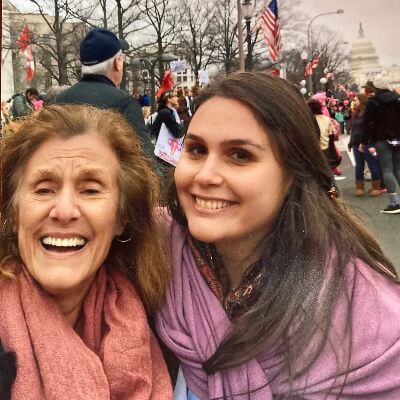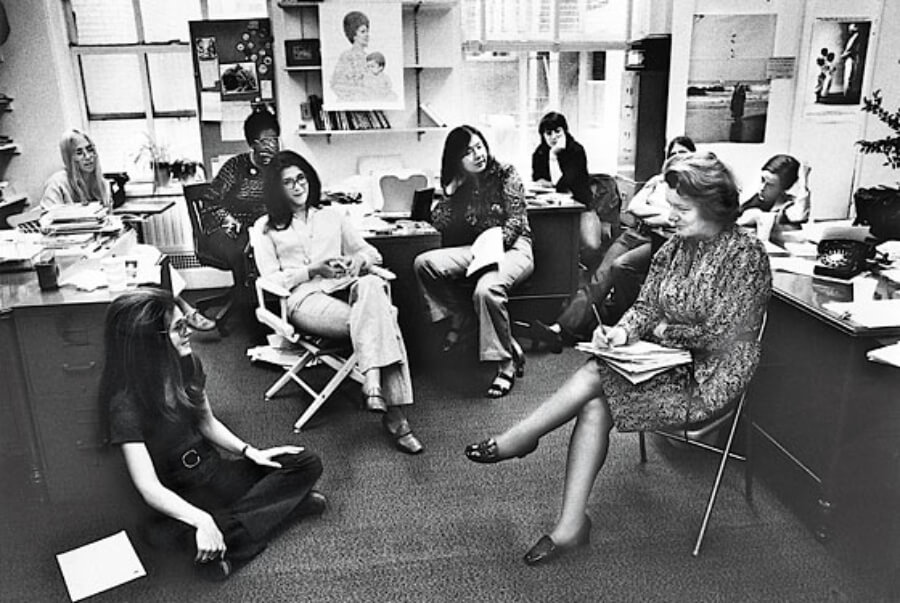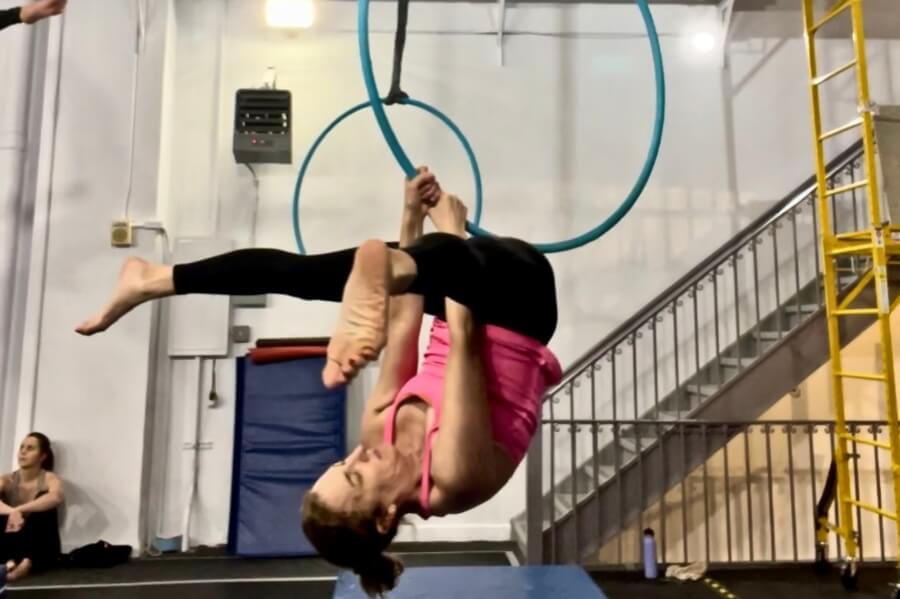Photo above: An early editorial meeting in the Ms. Magazine offices. Suzanne Braun Levine is in the center in the director’s chair—wearing pants. Photo by Nancy Crampton.
***
Fifty years ago this spring Ms. magazine appeared on the newsstand. For the first 17 of those years, I was editor, and although it is now owned by others, I will always feel connected to the magazine and the women whose lives it changed. Including me. When, on my first day, I stepped into the dingy two-room editorial office bustling with activity, I was coming from a world that is hard to picture today. This was the “real world” for a young woman at the time:
I couldn’t get a credit card without my husband’s signature.
I had had an abortion, which was not only illegal, but terrifying, painful, and risky as well.
Role models were hard to find. In business, congress, medical school, sports, academia, TV news, or on the supreme court. And, of course, all my doctors were men.
I was a very “well educated,” but women’s history was totally unknown territory.
One my first day at Ms., I appeared in “appropriate business attire”—a pink silk blouse, a pink cashmere pencil skirt, and a girdle!
I was a member in good standing of the Harvard club, but I had to enter through a side door and go up a flight of back stairs to the “women’s dining room.” And of course, like most restaurants, women in pants were not admitted.
When I was looking for a job in the Want Ads, I had to go past the most interesting postings (“help wanted/male”) to “help wanted/female,” where lower paying, less prestigious jobs were the only ones listed.
It was understood that if you had a date with a girlfriend and a boy asked you out, he took priority.
As a Tom Boy (don’t you love the phrase?), I loved sports. In high school I was proud to make the varsity basketball team but bewildered by the fact that we girls had to play a half-court game.
I resisted wearing dresses, which were the prevailing “feminine” uniform. But there were no alternatives. That’s why I appeared in “appropriate business attire” for my first day at Ms.—a pink silk blouse, a pink cashmere pencil skirt, and a girdle!
Looking back, it’s hard to imagine how and why we put up with it.
Read More: Dolly Parton Was a Feminist Even Before The Women’s Movement Launched
The Early Days
The Women’s Movement—“Women’s Lib”—challenged all that. Jane O’Reilly, writing in the first issue of Ms., coined the one-word description—“Click!”—of that “moment of truth” when it dawns on you that something is not right. My first “click!” struck that first day at Ms. My fancy outfit clearly didn’t lend itself to sitting on the floor with the other editors. I got the message that in getting dressed, we had a choice, and one option was comfort. I wasn’t crazy to favor pants.
“You aren’t crazy” was one of the reassuring messages behind the stories that ran in Ms. and the Movement itself; the other was “you are not alone.” The more we shared the truth about our lives, the more validated we felt, and as our numbers grew, so did our strength.
The more we shared the truth about our lives, the more validated we felt.
In the early days, it looked like change was on the way. The magazine celebrated a string of breakthroughs, including what looked to be the imminent passage of the ERA, which would add equal rights for women to the Constitution, and the Supreme Court Decision in Roe v. Wade, which appeared to give women control over their own bodies. History proved us wrong. On the other hand, Title IX, which opened equal opportunities for girls in sports, changed the playing field almost overnight. Soccer leagues sprung up in every town, and it became okay for girls to want to be strong and to win. But it took the intervening half century to complete the equalizing process. Just last year the World-Cup winning U.S. women’s soccer team sued the U.S. Soccer Federation, and won pay equity for professional athletes.
The pioneering handbook “Our Bodies, Ourselves” which came out in 1970 introduced us to our own bodies, which were unknown territory at the time. Women began to demand that their medical care reflect the same expertise. It took decades, though, before the pharmaceutical community, for example, figured out that they couldn’t test drugs on men only and assume that women were just smaller versions. Or that women presented symptoms to many diseases that even small men didn’t. As a result, for way too long women didn’t take those symptoms seriously either and were reluctant to “bother” the (male) doctor with frivolous complaints.
What’s Changed…And What Hasn’t

The author with her daughter at the Women’s March in January 2017.
It’s been a bumpy ride. While many breakthroughs, like abortion rights, didn’t turn out the way we expected, other achievements, like same-sex marriage, were beyond what any of us could imagine. “Sexual Harassment” a phrase that had to be invented before we could even talk about it (“It was just called ‘life’,” as Gloria Steinem put it) became the “Me Too” movement, which changed the workplace culture. Other cultural shifts were more symbolic, but also monumental. For example, for decades the cosmetics industry promoted the notion that beauty and youth were synonymous. With covid restrictions, women were prevented from slavishly coloring their hair and an impressive number began to take pride in their natural silver, confirming that beauty and age were just as compatible.
I see the Women’s March in January 2017, which brought half a million women to Washington—and millions more into the streets all over the country—as an important inflexion point in the ongoing pursuit of equality. It was a heady experience to be there, especially to have my daughter with me. The crowd was so large that it was impossible to actually march— the entire route was already full. Inspired by one woman’s post, it was a spontaneous expression of outrage at a thwarted dream—the first woman president. It was a remarkably diverse group in terms of race, age and gender. There were young people, many of whom were already old hands at protesting, and older women, like me, who were a little weary. And plenty of men.
I see a changed world, which is still in process and still inspiring.
There was also a group that I was especially interested in, women who had grown up in the changing world and built expertise and agency in their own lives but had been too busy to focus on the feminist agenda. Now, they had been there, done that and were ready and equipped for a new challenge. The March galvanized them. “I had no intention of coming to Washington,” one woman told me there. “I’ve never done anything like this before, but my college roommates who I hadn’t seen for twenty years decided to make it a reunion, and I just thought ‘What the hell. Why not?’” The collective energy she found there clarified her commitment to the unfinished business of “Women’s Lib.” She is one of the graduates of the last fifty years, ready to join the march into the next. One thing is for sure: they don’t need to learn that they are not alone.
All in all, looking back, I see a changed world, which is still in process and still inspiring. I go crazy when I think that Roe v. Wade may be cut down, but I get choked up when I see the President deliver his State of the Union in front of the two next highest office holders in the land, Vice President Kamala Harris and Speaker of the House Nancy Pelosi. Or when I learn that a friend’s 11-year-old granddaughter is a champion wrestler. I couldn’t have anticipated moments like that when I walked into the Ms. office—wearing a girdle.
Read More: As All in the Family Turns 50, We Look at What We Learned From Edith Bunker
Top photo by Nancy Crampton
***
Suzanne Braun Levine is author of a series of books about women over fifty: Inventing the Rest of Our Lives, Fifty is the New Fifty, How We Love Now: Sex and the New Intimacy in Second Adulthood, and You Gotta Have Girlfriends: A Post-fifty Posse is Good for Your Health





















0 Comments